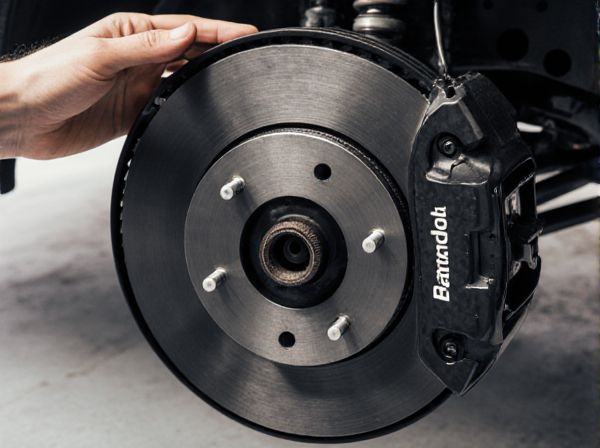
Photo illustration: Full Ceramic Rotor vs Carbon-Carbon Rotor
Full ceramic rotors offer superior heat resistance and reduced brake fade compared to traditional carbon-carbon rotors, making them ideal for high-performance street vehicles. Carbon-carbon rotors excel in extreme conditions such as racing, providing exceptional thermal stability and weight reduction but require higher operating temperatures to perform optimally. Your choice depends on whether durability and everyday performance or peak high-temperature efficiency is the priority.
Table of Comparison
| Feature | Full Ceramic Rotor | Carbon-Carbon Rotor |
|---|---|---|
| Material Composition | Ceramic fibers with composite matrix | Carbon fiber combined with carbon matrix |
| Weight | Lightweight, reduces unsprung mass | Ultra-lightweight, superior weight savings |
| Thermal Performance | Excellent heat dissipation, stable at high temperatures | Exceptional heat tolerance, maintains performance above 1,000degC |
| Durability | High wear resistance, long service life under typical conditions | Extremely wear resistant in racing conditions but sensitive to moisture |
| Cost | High initial cost, cost-effective over lifespan | Very high cost, limited to high-performance or racing applications |
| Performance Application | Sports cars, daily performance driving | Formula 1, endurance racing, high-performance track use |
| Moisture Sensitivity | Low sensitivity, reliable in wet conditions | High sensitivity, potential for reduced performance when wet |
Introduction to Brake Rotors
Full ceramic rotors offer superior heat resistance and reduced weight compared to traditional materials, enhancing braking performance and durability in high-performance vehicles. Carbon-carbon rotors excel in extreme racing conditions, with exceptional thermal stability and lightweight properties, but come at a higher cost and require precise temperature management. Understanding these materials' thermal conductivity, wear resistance, and application-specific benefits is crucial for selecting the optimal brake rotor for performance and longevity.
What Are Full Ceramic Rotors?
Full ceramic rotors are brake discs constructed entirely from ceramic composite materials, offering superior heat resistance and lightweight properties compared to traditional metal rotors. These rotors provide enhanced braking performance and durability, particularly under high-temperature conditions, making them ideal for high-performance and luxury vehicles. Unlike carbon-carbon rotors, full ceramic rotors exhibit lower thermal expansion and reduced brake fade, ensuring consistent stopping power and extended lifespan.
Overview of Carbon-Carbon Rotors
Carbon-carbon rotors offer exceptional heat resistance and lightweight properties, making them ideal for high-performance braking systems in aerospace and motorsports. These rotors maintain consistent friction at extreme temperatures, significantly reducing brake fade during intense use. Their enhanced durability and thermal conductivity exceed that of full ceramic rotors, providing superior performance in demanding conditions.
Material Properties Comparison
Full ceramic rotors, typically made from silicon carbide ceramics, offer superior thermal stability and wear resistance with a high melting point around 2730degC, providing excellent performance under extreme braking temperatures. Carbon-carbon rotors consist of carbon fiber reinforced carbon matrix, delivering exceptional heat dissipation, low density for reduced unsprung weight, and high friction coefficients ideal for high-performance and racing applications. Both materials provide enhanced durability compared to traditional steel rotors, but full ceramic rotors excel in corrosion resistance and longevity, while carbon-carbon rotors outperform in thermal shock resistance and lightweight responsiveness.
Performance in High-Temperature Conditions
Full ceramic rotors maintain exceptional performance under high-temperature conditions due to their superior heat resistance and minimal thermal expansion, resulting in consistent braking power and reduced brake fade. Carbon-carbon rotors excel in extreme heat environments, commonly exceeding 1,000degC during racing scenarios, offering outstanding thermal stability and lighter weight but with higher cost and specific maintenance requirements. The choice between full ceramic and carbon-carbon rotors depends on the application, with carbon-carbon preferred in professional motorsports for peak performance at extreme temperatures, while full ceramic rotors provide durability and reliability in high-performance street and track use.
Weight and Efficiency Differences
Full ceramic rotors typically weigh less than carbon-carbon rotors due to their dense but lightweight ceramic composite structure, enhancing overall vehicle weight reduction and improving acceleration. Carbon-carbon rotors, while heavier, offer superior thermal efficiency and consistent braking performance at high temperatures, making them ideal for extreme racing conditions. The weight advantage of full ceramic rotors contributes to reduced unsprung mass, whereas carbon-carbon rotors excel in endurance and heat dissipation efficiency under intense braking stress.
Durability and Longevity
Full ceramic rotors offer exceptional corrosion resistance and maintain consistent performance under high temperatures, resulting in impressive durability and longevity. Carbon-carbon rotors excel in extreme thermal endurance and lightweight properties, making them ideal for high-performance racing applications but often require more frequent replacement. In terms of wear resistance and lifespan under regular driving conditions, full ceramic rotors generally provide longer service life compared to carbon-carbon variants.
Cost and Availability
Full ceramic rotors generally have a higher upfront cost but offer superior corrosion resistance and longer lifespan, making them cost-effective over time despite limited availability primarily from specialty manufacturers. Carbon-carbon rotors are significantly more expensive due to their advanced materials and manufacturing complexity, commonly used in high-performance or racing applications with limited production and availability. Availability for full ceramic rotors is more widespread in aftermarket and OEM sectors, whereas carbon-carbon rotors remain rare and costly with strong emphasis on performance.
Applications in Automotive and Motorsport
Full ceramic rotors offer exceptional heat resistance and durability, making them ideal for high-performance road cars needing consistent braking under extreme conditions. Carbon-carbon rotors excel in motorsport applications due to their lightweight properties and superior thermal conductivity, providing enhanced fade resistance and quicker cooling during repeated high-speed braking. Both rotor types improve vehicle performance, but carbon-carbon is preferred in professional racing while full ceramic suits advanced street and track use.
Which Rotor Type Should You Choose?
Full ceramic rotors offer excellent heat resistance and reduced weight, making them ideal for high-performance vehicles requiring consistent braking under extreme conditions. Carbon-carbon rotors excel in ultra-high temperature environments and provide superior fade resistance, preferred in professional motorsport applications despite higher cost and maintenance. Choosing between the two depends on your driving style, budget, and performance needs, with full ceramic rotors suited for street use and carbon-carbon rotors optimized for track performance.
 caratoz.com
caratoz.com